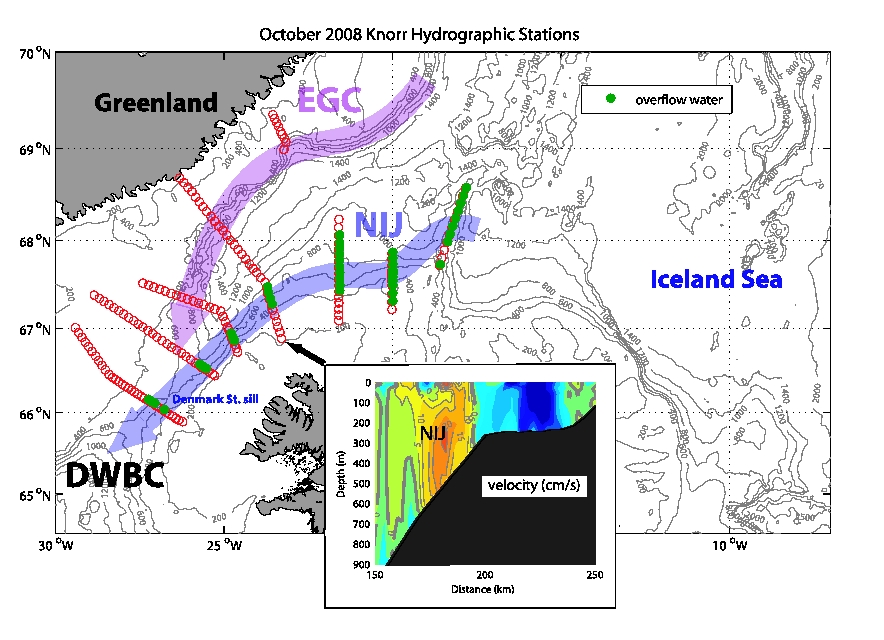NORTH ATLANTIC as the source of the NATURAL VARIABILITY
The North Icelandic Jet is a deep-reaching current
that flows along the continental slope of Iceland. North Icelandic Jet advects overflow water into the DENMARK STRAITand constitutes a pathway
that is distinct from the East Greenland Current. It is a cold current
that runs west across the top of Iceland, then southwest between Greenland
and Iceland at a depth of about 600 meters (almost 2,000 feet). North Icelandic Jet (NIJ), contributes to a key
component of the Atlantic Meridional Overturning Circulation (AMOC), also
known as the "great ocean conveyor belt," which is critically important
for regulating Earth's climate. As part of the planet's reciprocal
relationship between ocean circulation and climate, this conveyor belt
transports warm surface water to high latitudes where the water warms the
air, then cools, sinks, and returns towards the equator as a deep flow. Crucial to this WARM-TO COLD oceanographic
choreography is the DENMARK STRAIT Overflow Water (DSOW), , the largest of
the deep, overflow plumes that feed the lower limb of the conveyor belt
and return the dense water south through gaps in the Greenland-Scotland
Ridge.

LET'S START AT KOLBEINSEY RIDGE NORTH OF ICELAND


WHOI article :To the Denmark Strait
The Icelandic Jet is not only a major contributor to the conveyor belt, but the major source of the ocean's densest, coldest water.
DENMARK STRAIT IS BOTTLENECK ON THE SUPERHIGHWAY IN THE OCEANS GLOBAL CIRCULATION
Woods Hole Oceanographic Institution

The North Atlantic's Subpolar gyre (see the image above) is the engine of the heat transport across the North Atlantic Ocean. This is a region of the intense ocean - atmosphere interaction (see image below). Cold winds remove the surface heat at rates of several
hundred watts per square meter, resulting in deep water convection. These changes in turn affect the strength and
character of the Atlantic thermohaline circulation (THC) and the horizontal flow of the upper ocean, thereby altering the
oceanic poleward heat transport and the distribution of sea surface temperature (SST).
The thermohaline
forcing, associated with deep water convection, is thought to be the source of the 'Icelandic Low'.
Icelandic Low is a semi-permanent, subpolar area of low atmospheric pressure in the North Atlantic
Ocean. The strength of the Icelandic Low is the critical factor in determining path of the polar jet stream over the
North Atlantic.

The Icelandic Low is a semi-permanent centre of low atmospheric pressure found between Iceland and southern Greenland. It is a principal centre of action in the atmosphere circulation of the Northern Hemisphere, associated with frequent cyclone activity.
North Atlantic Ocean atmospheric pressure system is dominated by Icelandic Low because of the intense ocean - atmosphere interaction. Heat loss to the atmosphere from the North Atlantic currents is at rates of several hundred watts per square meter, resulting in deep water convection - thermohaline forcing).
ICELANDIC LOW IS THE PRINCIPAL COMPONENT OF THE NORTH ATLANTIC OSCILLATION - NAO. 
Changes in Jet Streams trajectory are due to changes in the intensity of the Icelandic Low,
and consequently determine the type of North Atlantic Oscillation Icelandic Low is strongest during a Northern Hemisphere winter and early spring, centred over Iceland and southern Greenland, and is the dominate weather feature in the area. During the summer, it is weaker, less intense, and might divide into two parts. Then the Azores or Bermuda High becomes the dominate weather feature in the North Atlantic.

350 YEARS LONG CET RECORD
Summers - Icelandic Low located North of Iceland is weak = no temperature rise for 350 year
Winters - Icelandic Low, located south of Iceland is Strong = gradual temperature rise for 350 year

CENTRAL ENGLAND TEMPERATURE and the NORTH ATLANTIC GEOLOGICAL RECORDS
NORTH ATLANTIC TECTONICS as THE Driver of the North Atlantic Currents Balance in the DENMARK STRAIT



MAGNETIC FIELD CHANGE AT KOLBEINSEY RIDGE
AS A PROXY FOR GEOLOGICAL ACTIVITY

AND FINALLY SOLAR AND TECTONICS

BACK TO THE START


© m.a. vukcevic